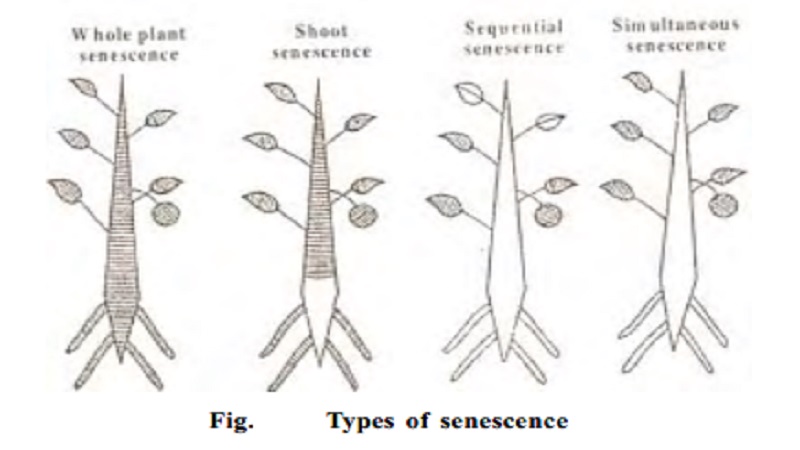Chapter: 11 th 12th std standard Bio Botany plant tree Biology Higher secondary school College Notes
senescence : Types, Physiology , Importance of senescence

Abscission and Senescence
The process of separation of leaves, flowers, and fruits from the plant is called abscission. It is essential, when these parts are removed that the plant seals off its vascular system to prevent loss of water and nutrients and to exclude bacteria, fungal sporesand other pathogens. An abscission zone, a layer of specialized cells is formed at the base of each part before it is lost, to separate it form the main body. The cells in this layer die and become hardened by the deposition of ligning and suberin. So, by the time the leaf or fruit drops, the vascular system has been
sealed off.
Mechanism of Leaf Senescence
As the young plant grows, it undergoes ageing and develops into mature plant in an orderly fashion. The later part of the developmental process which ultimatelyleads to death is called senescence.
Senescence may be defined as the period between reproductive maturity and death of a plant or a part of it. It is characterized by a collective, progressive and deteriorative developmental process which ultimately leads to completeloss of organization and function of the plant or parts of it. The study of plant senescence is called phytogerontology.
Types of Senescence
Leopold(1961) has recognized 4 types of senescence patterns, which are as follows:-
1. Whole plant senescence
2. Shoot Senescence
3. Sequential senescence of Organ senescence
4. Simultaneous senescence
1. Whole plant senescence
It is found in monocarpic plants which produce flower and fruit only once in their life cycle. The plants may be annual(e.g. rice, wheat, gram, mustard etc.), biennials(e.g.cabbage, henbane) or perennials (e.g. certain bamboos). The plant dies soon after ripening of seeds.
2. Shoot senescence
This type of senescence is found in certain perennial plants which possess underground perennating structures like rhizomes, bulbs, corm etc. The above ground part of the shoot dies each year after flowering and fruiting, but the underground part (stem and root) survives and puts out new shoots again next year. E.g.banana, gladiolus, ginger etc.
3. Sequential Senescence
This is found inmany perennial plants in which the tips of main shoot and branches remaining a meristematic state and continue to produce new buds and leaves. The older leaves and lateral organs like branches show senescence and die. Sequential senescence is apparent in evergreen plants. e.g.Eucalyptus, Pinus etc.
4. Simultaneous or Synchronous senescence
It is found in temperate deciduous trees such as elm and maple. These plants shed all their leaves in autumn and develop new leaves in spring. Because of this shedding of leaves, autumn season is also called fall. Such a senescence of leaves or plant organs is called synchronous.
Physiology of senescence
The process of senescence involves a number of structural and physiological changes in the senescing organs. Some of the important changes are:
i) Cells undergo reduction in their size.
ii) The membrane bound sub-cellular inclusions are disrupted.
iii) Photosynthesis is reduced and starch content decreases in the cells.
iv) Breakdown of chlorophy II is accompanied by synthesis and accumulation of anthocyanin pigments.
v) Protein synthesis is decreased and protein break down enhances.
vi) Amino acids are withdrawn from senescing leaves and transported to the growing regions.
vii) RNA content is decreased.
viii) Chromatin material changes its property and DNA molecules degenerate.
Importance of senescence
Biologically senescence and death have following advantages
1. It maintains efficiency since the old and inefficient organs are replacedby young efficientparts like leaves, buds, flowersand fruits. etc.,
2. During senescence, the celluar breakdown results in release of many nutrients including amino acids, amides, nnucleotides, simple sugars and minerals. The same are withdrawn from the senescing organs into the main trunk and later utilized in the growth and development of new parts.
3. Shoot senescence is a mechanism to help the plants perennate during the unfavorable periods.
4. Simultaneous or synchronous leaf fall occursin autumn prior to winter. It reduces transpiration, which is essential for survival in winter, when the soil is frozen and roots cannot absorb water.
5. Liter of fallen leaves and twigs is an important source of humus and mineral replenishment for the soil.
Related Topics